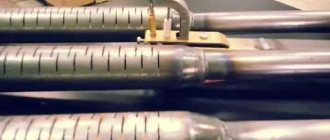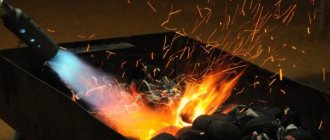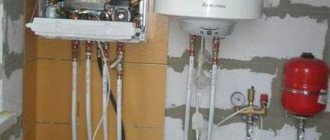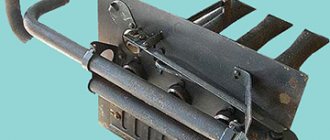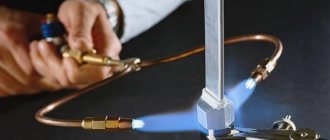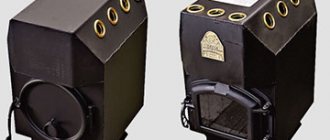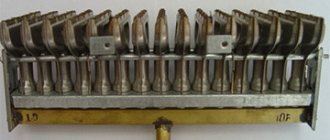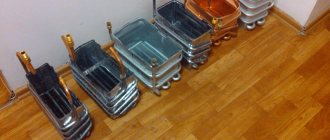Converting a brick or metal stove to gas processing is a difficult process that requires a serious analysis of all components. It is imperative to find out which types of gas burners are ideal for furnaces and which ones should not be installed. After all, the result must meet exactly your requirements.
It would seem that the choice of model can be entrusted to gas workers; they can also be entrusted with reworking the burner block and installing the burner itself. But where is the guarantee that the equipment that you will be offered to install will have the necessary operating parameters and desired functionality?
In this article we will tell you how to independently understand the types of gas burners, the basic rules for their installation and operation, so that you can consciously choose which device to install in your heating stove.
Permits and requirements for installing gas equipment in a bathhouse
Like any gas equipment, installing burners on a sauna stove requires permission from the gas supply organization. If we talk about the use of atmospheric models, they are very reluctant to issue them. When issuing, the following requirements apply:
- good ventilation system;
- excellent adjustable traction;
- a room with a volume of at least 12 m3;
- ensuring fire safety measures when installing the stove;
- insulation of the chimney as it passes through the ceiling and roof;
- the presence of a spark arrestor at the top of the pipe.
If these requirements are met and you have a Certificate of Compliance and a Rostechnadzor permit, you may be given a permit.
https://www.youtube.com/watch?v=ytaboutru
When installing pressurized gas burners, permission is also required, but some requirements for the premises are not imposed (ventilation, draft and volume are unimportant, all others remain in force). When following the installation rules, it is enough to have certificates of conformity and an operating permit from Rostechnidzor (included upon purchase).
But this is only when using main gas. Liquefied gas must be stored somewhere. According to the requirements of the pozhnadkhor - in a separate room. And this is not a dressing room, canopy, etc. This must be a separate room. In principle, a free-standing metal cabinet or gas holder is suitable for storing liquefied gas cylinders - an underground container measuring 3 cubic meters or more (should be located no closer than 5 meters to the building).
A pipeline is laid from the gas storage site to the furnace. It must be made of non-flammable materials - copper or steel pipes. It must be completely sealed (be sure to check all connections).
GENERAL OCCUPATIONAL SAFETY REQUIREMENTS
1.1. An employee who is at least 18 years old, who has undergone a medical examination and has no contraindications for health reasons, who has the necessary theoretical and practical training, who has completed introductory and initial workplace safety briefings and training according to a special program, and who is certified, is allowed to perform work using a gas burner. qualification commission and received permission to work independently. 1.2. An employee who performs work using a gas burner (hereinafter referred to as the employee) must periodically, at least once a year, undergo training and testing of knowledge of labor protection requirements and receive permission to perform high-risk work. 1.3. An employee, regardless of qualifications and work experience, must undergo repeated training on labor protection at least once every three months; If an employee violates labor safety requirements, as well as during a break in work for more than 30 calendar days, he must undergo an unscheduled briefing. 1.4. An employee who has not undergone timely instructions and testing of knowledge of labor protection requirements is not allowed to work independently. 1.5. An employee performing work using a gas burner, who is allowed to work independently, must know: safety measures when using gas cylinders and burners. Rules, regulations and instructions for labor protection and fire safety. Rules for the use of primary fire extinguishing agents. Methods of providing first aid in case of accidents. Internal labor regulations of the organization. 1.6. An employee sent to participate in work unusual for his profession must undergo targeted training on the safe performance of the upcoming work. 1.7. An employee is prohibited from using tools, devices and equipment that he has not been trained in the safe handling of. 1.8. When performing work using a gas burner, an employee may be exposed mainly to the following dangerous and harmful production factors: - the possibility of a fire when using a gas burner; — the possibility of a gas cylinder explosion; — gas burner surfaces heated to high temperatures; - uncomfortable working position. 1.9. An employee performing work using a gas burner must be aware that during work, the most likely cause of injury may be burns from the open flame of a gas burner. 1.10. To protect against the effects of dangerous and harmful production factors, the employee must use special clothing, safety shoes and other personal protective equipment. 1.11. To prevent the possibility of a fire, the employee must comply with fire safety requirements himself and prevent other employees from violating these requirements; Smoking is permitted only in designated areas. 1.12. The employee is obliged to comply with labor and production discipline, internal labor regulations; It should be remembered that drinking alcohol usually leads to accidents. 1.13. If an accident occurs with one of the employees, the victim must be given first aid, report the incident to the manager and maintain the situation of the incident, if this does not create a danger to others. 1.14. The employee, if necessary, must be able to provide first aid and use a first aid kit. 1.15. To prevent the possibility of illness, employees should observe personal hygiene rules, including thoroughly washing their hands with soap before eating. 1.16. It is not allowed to perform work while intoxicated or in a state caused by the consumption of narcotic drugs, psychotropic, toxic or other intoxicating substances, as well as drink alcoholic beverages, use narcotic drugs, psychotropic, toxic or other intoxicating substances at the workplace or during work. time. 1.17. An employee who violates or fails to comply with the requirements of labor safety instructions is considered a violator of industrial discipline and may be subject to disciplinary liability, and, depending on the consequences, to criminal liability; if the violation is associated with causing material damage, then the perpetrator may be held financially liable in the prescribed manner.
Types of portable burners
Gas burners are devices that differ in design and purpose, but they are united by a common feature - they operate using gas.
Portable devices designed to operate from a small tube filled with propane-butane or other gas should not be confused with ovens or powerful welding units that operate from natural gas or a large cylinder.
We offer a brief overview of the main design elements of an inexpensive gas cartridge burner, which serves as an excellent example of a home device. It may be useful for repairs in the country or for a barbecue.
Using a compact device, you can quickly light a barbecue, heat bolts or nuts in the cold, melt plastic parts, and process heat shrinks. The flame temperature (up to +1300°C) is enough for soldering metal pipes.
This is an example of a burner type that is popular among users, but the range of devices is much wider. Let's look at the most popular types.
Difference by area of use
An open flame may be required at home, on vacation, and during installation work. One of the areas of application is tourism. When camping, use a simple device to light a fire and heat up canned food.
Devices for heating food have a special design - instead of a muzzle-nozzle, there is a long thin gas supply hose to an external burner with a stand
Burners with a directional torch of a “pistol” type are often used in installation work when soldering copper pipes and for bending plastic elements.
The flame, heated to the required temperature, is directed to the mating area of the copper parts, resulting in a strong permanent connection between pipe and pipe or fitting.
High-temperature high-power lamps can also process steel parts, but this requires hard solder and a slightly modified soldering technique.
Gas portable burners are also used for the following work:
- processing of wooden parts;
- lighting a barbecue or a fire in the country without the use of chemicals;
- calcination and cutting of metal blanks;
- singeing animal carcasses during butchering;
- thawing frozen pipelines.
This useful device is always at hand for craftsmen who love to improve their homes and improve their garden plots on their own. The burner can be useful in a car repair shop, during the construction of a greenhouse or other structures.
Division according to the method of attaching the can
The fuel cartridge is a consumable item. As soon as the fuel runs out, it is disconnected from the burner, and a new cartridge is installed in its place.
There are several ways to attach a cartridge to a device:
- threaded - fixed with a thread, in other words - screwed on;
- collet - put on and slightly rotated to one side;
- valve - secured with a retainer;
- pierced - connected with light pressure.
Threaded models are more common than others. They form a strong connection between two elements that can be separated at any time. Punctureable ones, on the contrary, cannot be turned off until the gas in the can runs out.
Devices with collet fixation are quickly installed. To attach them to the cylinder, you just need to put them on and turn them 25-30 degrees to the side
The weakness of collet devices is the rapid loosening of the clamp, resulting in loss of gas.
Valve burners, which are usually designed for heating food, are considered more reliable.
Differences in gas burners by fuel type
Manufacturers use various fuels to fill consumable cartridges. The choice of liquefied gas is based on the purpose of the burners, the required flame temperature, and power. To improve the characteristics of the composition, several different types of fuel are sometimes mixed.
The following combinations of substances are used most often:
- a mixture of propane and butane (70:30) - mainly for summer use, but with a heating device it is also used in winter;
- a combination of propane, butane and isobutane in various proportions;
- a mixture of MAPP - methyl acetylene-propadiene-propane, most often used for welding at temperatures of 1600-2500 ° C.
But there are cans filled with one gas, for example, butane.
An example of inexpensive gas cartridges is “Pathfinder”. Price – 90 rubles. Filling – universal gas fuel, suitable for portable burners, cutters, stoves, heaters
The choice of fuel is important when work is to be done in harsh conditions - in the cold or at high altitudes. And in the summer, any universal gas is suitable for lighting a barbecue or fire.
Other differences
Let's consider the division of gas burners by type of ignition. The simplest option is with a burning igniter (wick). When the automation is triggered, the wick ignites the gas and the boiler begins to heat the coolant. There are two disadvantages here - increased gas consumption and low safety (the igniter may go out). Primary ignition is carried out with matches or using a piezoelectric element that produces a spark.
Natural gas from the mains provides even combustion without forming excessive soot on the walls of the chimney pipe.
Electronic ignition of the burner requires the presence of a high-voltage converter in the gas boiler. Energy is taken from batteries or the electrical network. The first option is used in non-volatile boilers that do not have electronic automation. The second option is relevant for complex units with electronics on board. Along with such ignition, modules for ionization control of the presence of flame are often installed.
There is also a division according to the type of fuel used. Natural gas supplied from the pipeline is cleaner, it is supplied at optimal pressure (we do not consider cases of pressure surges in both directions). The flame in the boiler is clean, without soot. The equipment is connected to the network without modifications. There are burners that can operate on propane - this requires setting up the system and installing a jet. The flame from propane combustion gives off a yellow color, and there is increased soot deposits on the chimney.
Jets allow you to normalize the propane pressure to an acceptable value - they are supplied as a set or purchased separately.
Making gas burners yourself: to do or not
One more thing: you will never get permission to use a homemade burner. You can, of course, install equipment without permission, but the fines are too high.
It’s not for nothing that people call gas stoves “bombs” - and all because people are used to trusting sellers at their word and at one time purchased stoves of dubious origin. Because of what - explosions, fires, burns. This is why there is a common myth that gas and electric stoves for steam rooms are taboo.
Each burner for a gas furnace has its own specific fuel consumption value, which determines the efficiency and power of the unit. So, for a small bathhouse, a gas burner for a boiler with a flow rate of 1.5-4.5 cubic meters will be sufficient. at one o'clock. Moreover, you can purchase it with the required power for an existing stove - this is a replaceable element
But it is important that the characteristics of the threaded connection of the burner itself and the gas supply source to the boiler completely coincide
And finally, all gas stoves for baths must have documentation confirming the state safety and quality standard - if the seller does not have one, then it is better to avoid his store.
https://www.youtube.com/watch?v=https:accounts.google.comServiceLogin
Absolutely unacceptable for steam rooms and burners for boilers of unknown manufacture, with damage or leaky connections, without a technical certificate or after the end of the permissible service life
In a word, the burner for a gas sauna stove must be in impeccable condition and periodically undergo preventive inspection - this is important for the health and life of people relaxing in the sauna.
Gas-fired sauna stoves are modern universal designs that differ from traditional ones in the ability to use different types of fuel in them: natural gas, liquid hydrocarbon gas, and firewood. All this is ensured by the fact that gas-burning stoves have additional removable elements - devices for solid fuel and gas-burning equipment.
The process of installing a gas stove must be approached with responsibility - both the efficiency of the stove and the safety of its use depend on this. It is best to entrust this to qualified workers - all seller companies offer such services. And in any case, during the installation process you need to keep an eye on the following:
- The distance from the wall to the stove must be at least 5 meters, and the walls themselves must be made of fireproof materials or lined with such materials.
- The refractory base of the stove must protrude at least 10 cm from all its edges.
- The dimensions of the opening for the burner without a cover should be: 47-55 cm high and 35-45 cm wide; with overlay: 61.5-68 cm high and 51.5-66.5 cm wide.
An example of marking openings for installing a stove. They may vary depending on the model
In the dressing room you definitely need to have exhaust ventilation and a window with a window - there is gas after all. Doors should be made to open outwards, and the height of the chimney should be no less than 5 meters from the burner level
Very important: the place where the stove is connected to the chimney must be perfectly sealed
Approximate installation diagram of a gas stove and its structural components
If you are wondering whether it is worth purchasing such a stove for your bathhouse, do not hesitate: gas sauna stoves are not only easier and cheaper to operate - they are also cleaner, more environmentally friendly, and much more functional.
Combustion process in a boiler
The chemical reaction inside the boiler is a combustion reaction between oxygen (O2) in the air and hydrocarbons (CHyOx) in the fuel, which release energy as heat. During the combustion process, water vapor (H2O) and carbon dioxide (CO2) are formed, the latter being especially dangerous in terms of air pollution and global warming.
Other combustion products of injector gas may also appear depending on the type of fuel and combustion conditions: oxides of nitrogen (NOx) or sulfur (SOx), which are responsible for acid rain. Carbon monoxide (CO), a dangerous toxic substance, can cause death if inhaled.
Correct adjustment of the device reduces the amount of harmful combustion products. CO2 emissions are reduced when the gas is completely burned. In order to reduce NOx emissions, it is recommended to use the correct combustion technology, which is ensured by the design of the burner device.
Types and characteristics of elements for gas combustion
The gas burner for the boiler is selected according to the following characteristics:
- Life time. The period cannot be less than the operating life of the heater.
- Low noise level. If the injectors make a lot of noise, this indicates a malfunction - all parts are checked at the factory and must comply with sanitary and hygienic standards.
- Type of fuel. Manufacturers offer universal nozzles that operate on main gas, bottled gas, diesel fuel, etc. When changing the energy carrier, a simple reconfiguration of the equipment is required - such burners are especially convenient for owners of country houses.
- Easy to install and dismantle.
The main purpose of the device is to mix gas and air to form a flammable medium. The efficiency of the burners is high; the type of mixing differs between atmospheric and fan. It is worth considering their features in more detail.
Atmospheric burners
To form a combustible substance, the burners take air from the room where the heater is installed. Atmospheric gas burners for heating boilers operate on the ejector principle - nozzles for supplying gas are located inside the channel structure. Air is delivered to the nozzles, then a combustible mixture is formed, exiting through the perforation of the nozzle.
As the mixture exits, a low air vacuum is created, which allows oxygen to be drawn in and a new portion of the mixture to be formed. The gas combustion chamber is equipped with several parallel channels with nozzles, so the process of forming the gas-air mixture is carried out in a continuous cycle.
After combustion, the heated gas moves to the upper part of the heat exchange structure, giving off heat to the heat exchanger, and then the combustion products are drawn into the chimney. The warm gas reacts with the cold outside air, resulting in the formation of draft, which provides the supply of fresh air to form a gas-air mixture.
Advantages of atmospheric gas devices:
Simplicity and relative cheapness; there will be no problems with replacing equipment. Energy independence. No electricity is required to start the boiler
It is important to maintain an optimal level of fuel supply pressure and build a high-quality chimney. Low noise level, compact device.
The disadvantages include the necessity of constructing a chimney so that combustion products are completely removed.
As for the efficiency of the equipment, it is quite high, since manufacturers are increasing the number of inlet holes with a small diameter. This “perforation” ensures uniform distribution of the gas-air mixture throughout the combustion chamber, increasing the performance and energy efficiency of the system.
Fan burners
These are more complex gas burners for heating stoves, allowing control of the fuel combustion process. The fan is installed to force air into the combustion chamber and ensures the formation of a gas-air mixture in a sealed compartment for fuel combustion.
Fan-type nozzles are used in combined heaters equipped with a sealed combustion chamber.
Device Features:
- high efficiency;
- forced air injection;
- the optimal combination of portions of gas and oxygen to form a combustible mixture.
In addition to pumping air into the chamber, the fan is responsible for removing combustion products to the outside and allows you to change the pressure in the network by changing the speed of rotation of the blades.
The main difference between fan nozzles and atmospheric ones is the formation of a combustible mixture. In atmospheric boilers, a gas-air portion is formed at the entrance to the burner, in fan boilers - at the entrance to the combustion chamber.
A fan gas nozzle for heating a private home has a wide list of advantages:
- Monitoring the operation of the network, the ability to influence the process of forming the gas-air mixture, and change the boiler power.
- Saving fuel consumption.
- High efficiency.
- Can be installed in apartments and small buildings. This is achieved by eliminating the need to connect to a standard chimney. The coaxial pipe is run through the nearest exterior wall.
Domestic gas fan heaters are expensive energy-dependent devices, which is a disadvantage of the units. If the device breaks down, only a specialist can replace it, and the burner turns off if there is a failure in the supply of fuel or electricity.
Oven nozzle
Gas stove burner is used to burn gaseous fuels such as gas. They are available as atmospheric or pulse burners. When comparing the two systems, especially the blower burners provide very clean and efficient combustion of gas products in all power ranges by precisely controlling the supply of fuel and combustion air.
Modern and compact heaters currently use mainly flat burners, in which the flame is distributed over several nozzles over a larger area. The operator's hand makes the combustion particularly efficient and also cleaner due to the lower temperature. Particularly favorable and clean is the so-called catalytic combustion, in which the gas enters into a chemical oxidation reaction on the surface of the catalyst with oxygen from the air. This process does not require conventional ignition and is characterized by a very low flame temperature.
List of sources
- sovet-ingenera.com
- build-experts.ru
- www.steklogaz.ru
- udobnovdome.ru
- obrabotkametalla.info
- master-kleit.ru
- chebo.biz
- remoo.ru
Atmospheric gas burners
The name “atmospheric” burner was given for the method of supplying fuel (natural or liquefied gas) and air to the combustion zone - by analogy with the burners of a gas stove for cooking. Another, “scientific” name for an atmospheric burner is “gas burner for a boiler with an open combustion chamber.”
Structurally, the structure of a gas burner for a boiler is as follows: a steel tube (tubes) in the walls of which there are a number of holes for gas to escape into the combustion zone.
The gas enters the tube through the device's piping system, exits into the combustion zone, mixes with the surrounding air, ignites from the wick burner and, when burned, heats the heat exchanger or coolant container. In turn, the wick burner is ignited from a piezoelectric element or ordinary household matches.
Within the “atmospheric” type, the design of the burners may differ in geometric shape, as well as in the number of tubes and holes in the tubes. Typically, the main components of a standard gas stake have three types of burners:
- Ignition. Serves to ignite the main burners and operates in “standby” mode (continuously).
- Main. Turns on when the set coolant temperature drops below the temperature sensor differential.
- Economical. It operates in semi-duty mode within the temperature sensor differential value.
Atmospheric burners are characterized as simple energy-independent devices for completing gas boilers of low thermal power. Gas boilers with high thermal power are equipped with turbocharged burners for safety reasons.
It should be noted that, despite their simple design, homemade gas burners for “atmospheric” type boilers cannot be put into operation - any gas equipment or their parts and components can be produced exclusively by specialized production facilities that have a package of permits.
Turbocharged burners
In accordance with the name, the design of such a burner has a turbofan. This is a burner with a closed combustion chamber with forced air supply into the combustion zone. Air is supplied through special channels by one or more electric turbofans.
Advantages of turbocharged burners
- High level of safety - gas combustion occurs in a space isolated from the atmosphere of the room.
- High thermal performance. The heat exchangers of boilers equipped with such burners have a special design, due to which the most complete heat extraction occurs. This makes it possible to heat significant volumes of coolant and water for household needs per unit of time.
- Less sensitivity to drops in gas pressure in the main pipeline. The electric fans of the burner create sufficient “backup”, so the drop in gas pressure in this case is not as critical as for atmospheric burners, which, when the gas pressure drops, immediately go out on their own or are turned off by the automatic system.
- It is possible to replace it with a different type of burner, for example a diesel one.
Disadvantages of turbocharged burners
- Additional electricity costs.
- Energy dependence. When there is a power outage, the burner does not work, and the heating is turned off, while the atmospheric burner operates without electricity.
- Household gas burners for turbocharged boilers are characterized by increased noise levels caused by intense air movement in the channels and the operation of the fan impeller. In this regard, additional sound insulation (partitions or casing) or placement of the boiler in a separate room is required: in an extension, non-residential corridor, basement, etc.
What type of gas burner do you prefer?
For a small private house with an area of up to 200 m2, the best option is an atmospheric burner with a two-stage combustion setting (main and economical) and automatic setting. More accurate information will be provided by the design engineer who will develop the gasification project for your household.
Trouble-shooting
Having a boiler at home brings many advantages, but it also has a number of disadvantages, and the user does not always know what to do correctly. Boiler faults are common to many types. It is important to promptly determine the cause of these faults before calling emergency services. List of the most common and most likely faults.
First of all, if the boiler does not start, you need to check the circuit components:
- network voltage;
- faulty boiler fan switch or motor;
- damaged boiler cables;
- false triggering contacts of automation or commissioning equipment;
- availability of water, whether the gas boiler is powered to the minimum required level specified by the equipment manufacturer.
If the boiler failure is not caused by any of these problems, the following procedure:
- Pay attention to the noises made by the boiler, because they are often the first witnesses of destruction. They can also be due to hot water trapped inside the firebox or due to the presence of air in the heating system due to clogged air ducts.
- Pipe rupture. It usually occurs due to problems with a jammed boiler feed valve, various scale-forming deposits in the boiler, or a malfunction of the condensate drainage systems.
- Failures due to exceeding the pressure and temperature readings, their corresponding sensors can trigger, for example, due to a broken thermometer or, conversely, which is especially dangerous as a result of real overheating of the boiler.
- The heating circuits are not working, possibly due to poor quality of feed water and scale formation in the boiler pipes.
- A problem occurs with the burner (flame breaks, gas accumulation causes detonation and explosion).
For some of these problems, mainly pressure or temperature, the boiler monitor displays an error message, then the system shuts down and automatically restarts. If the problem persists after restarting, it is best to call a professional to troubleshoot the problem. It should be noted, however, that most of these failures can be avoided.
The best prevention is to have your boiler inspected, maintained and cleaned annually, usually by a professional. This will prevent the pipes from clogging and bursting. Prevention is better than restoration, and a simple annual inspection will protect the equipment and the health of users from possible emergency situations.
How to choose a good device?
The main characteristics of such products are:
- Thermal power.
- Characteristics of the gas that will be used in the product.
- The relative length of the flame leaving the burner.
- Design gas pressure in the furnace.
- Operating adjustment: ratio of theoretical thermal power to minimum.
- Limit adjustment: the ratio of the highest thermal power to the lowest.
- Chemical composition of the fuel.
- The noise level produced by the product.
When choosing a device, you need to keep the following factors in mind:
- Simplicity of design. In this case, the cross-sections of the paths for the passage of gas must be the same and create minimal resistance to the gas.
- Room size. For small rooms, an atmospheric device will be sufficient, but for larger rooms the power of such devices may not be enough.
- Manufacturer of the product. Domestic and foreign (mostly products made in Germany are on the market) units have approximately the same cost, but some similar devices are designed for installation in specific types of stoves. For example, the domestic product AGG-15 is suitable for use only in stoves with a long channel for the fuel mixture.
Photo 2. Gas nozzle AGG-26, suitable for furnaces with a long channel.
Type of heating device.
Important! You need to know where the fuel will come from to the heating device: from individual cylinders or from the main pipe. This is also taken into account when installing the stove
Bartolini Pullover K
The gas heater can be used in different types of premises: apartments and houses, outbuildings and garages. It can become either the main or additional source of heat. This device is quite mobile - it moves easily on wheels. The heating element will be a special Catholic panel.
It is created from special fiberglass, and the rally catalyst will contain platinum powder. Using this method, there will be no emissions of unpleasant odors in the room when the heater is operating. The fuel for the device is liquefied propane-butane. The design itself is such that the gas cylinder is placed inside and covered with a special casing. The heater also includes special protection elements:
- sensor for monitoring the burner flame indicator;
- sensor for monitoring the state of air in the room (automatic shutdown when the amount of carbon dioxide is exceeded);
- rollover protection (automatic shutdown in case of tilt).
Additional qualities:
- there is a power regulator;
- Piezo ignition.
Main advantages:
- silent operation process;
- reliability;
- high-quality production - Italy.
Disadvantages: heavy weight and size.
Setting the gas burner flame
In order to properly configure the burner of a gas boiler, you must first follow the operating instructions for the gas appliance. Next, we’ll talk about how to properly start and set up a gas burner, and in what cases flame adjustment is necessary. But first things first.
Features of boiler burner settings
It is recommended to adjust the burner flame using a gas analyzer. It shows information about the amount of air that is mixed with the gas, namely the level of oxygen involved in the process and the amount of CO.
Typically, CO should be no more than 50 ppm, oxygen concentration should be approximately 3 to 5%. If it is less, then most likely the gas will not have time to burn, as a result of which a lot of soot will accumulate, the CO2 level will be higher than normal, and the efficiency of the equipment will decrease.
If the air is more than normal, then the temperature of the household burner of the gas boiler will be too high, and this can lead to tragic consequences, including an explosion of the equipment.
To ensure maximum efficiency of the equipment, make sure that the gas burner flame is blue. If it is yellow or blue-orange, then an adjustment needs to be made, otherwise the gas will not burn completely and leave a lot of soot. This in turn will lead to damage to the device.
The flame in the gas burner should be blue. If you find that the color has an orange tint, then try reducing the amount of gas. Reduce until the color turns blue (blue). This color is a sign of optimal operation of the gas appliance. The main thing is not to reduce the fuel supply to the point where the flame becomes almost colorless. In this case, it will go out very quickly.
Setting the starting gas supply is only necessary during ignition and does not affect the performance of the device. But if necessary, it is possible to adjust it too. To begin with, you should reduce the starting fuel supply. Reduce until the burner stops turning on. After this, you can turn the regulator until ignition resumes. You can watch the video at the end of this article for more details on setting the flame of a household gas burner.
We also recommend that you familiarize yourself with the intricacies of adjusting a gas boiler.
When is flame adjustment necessary?
An atmospheric gas burner, which operates without a built-in fan, very often fails; a turbocharged one breaks down much less often. During prolonged use of the device, its components may break or stop working at full capacity.
A floor-standing gas boiler occupies the usable area of your premises, so such heating systems are suitable for private homes. Most often, a special room is allocated for such devices - a boiler room in which the boiler is installed. Wall-mounted boilers save space, so they are preferably installed in apartments or houses with a small area
For example, a gas boiler may experience reduced efficiency or a decrease in flame.
And this can happen for the following reasons:
- High burner power installed for equipment that is designed for less powerful burners. In this case, there is not enough space for proper combustion of fuel, the fuel burns unevenly, which leads to soot quickly accumulating on equipment parts.
- A lot of soot in the chimney can have a bad effect on the draft of a gas boiler. Because of this, the subsequent removal of combustion products is very weak, little air enters, and the flame becomes yellow.
- The presence of burner defects is one of the reasons for reduced boiler efficiency, but in this case, adjusting the flame will not help correct the problem.
- Pressure drops when supplying gas can also contribute to the formation of soot and carbon deposits, and this will significantly reduce the productivity of the equipment.
All these reasons can affect the flame temperature in the gas burner, in which case repairs will be required.
Wall-mounted heating boilers and gas water heaters are installed, most often, in apartment buildings. But they may also need to adjust the burner flame
Homemade units
There are craftsmen who remake heating systems with their own hands. On the Internet you can even find the necessary diagrams for changing the devices of gas burners, their installation and adjustment.
Typically, metal is used as a material for the manufacture of heating systems. A cast iron firebox would be much more reliable. However, it is not possible to use it at home.
An excellent option for manual work is to order the system from specialists. They will be able to manufacture the device in accordance with all the customer’s wishes. However, the possibility of defects in the boilers cannot be ruled out, which may appear after some time.
Why do you need homemade heating units? The fact is that the marked options have a lower cost. They are made mainly because of the desire to save money. At the same time, these options are inferior to their factory counterparts in efficiency.
Usually only solid fuel and electric units are manufactured. Making a gas or diesel boiler is extremely dangerous. In addition, their installation in the house is strictly prohibited.
According to the principle of operation, a homemade product is no different from a purchased version. It will burn fuel and heat the coolant filled with water.
The main disadvantage of this unit is the lack of warranty. Factory equipment will work and perform its functions. Even if the buyer stumbles upon a defect, he will be able to exchange the product for another.
It is better to use pellets, firewood, and coal as fuel in self-made units. These materials are less dangerous than gas. It is impossible to make heating devices based on the latter.
Simple solid fuel units are the most popular and widespread homemade devices. They are simple, and their design is in many ways similar to a conventional stove. In addition, they are versatile.
Like a conventional stove, these systems can operate on any solid fuel. The main thing is that it burns.
Main parts of a gas boiler.
The efficiency of homemade equipment is significantly lower than factory equipment. It is influenced by many factors.
Among them:
- thermal insulation;
- combustion completeness;
- the correctness of the conclusions.
The efficiency of the unit directly depends on the combustion temperature. The higher it is, the lower the efficiency. In high-quality systems, the temperature in the firebox is maintained at 120–150°C. Higher values reduce the safety of pipes. This in turn significantly reduces the durability of the unit.
When manufacturing heating boilers with a burner, it is better to protect yourself as much as possible from the possible consequences of its operation. Therefore, you should consider a separate purchase of an automatic gas burner, which will be installed in an atmospheric or blown boiler.
You can also make electric heating units with your own hands. Their design may vary. It all depends on the person’s needs. The simplest option is to install a heating element directly into the heating system. In this case, there is no need to make a boiler.
The pipe with the heater must have a sufficiently large diameter. It should be easily removable for repairs and cleaning.
Systems without a heater deserve special attention. Its role is played by water itself. A current is passed through it, and heating occurs due to the movement of water ions. The liquid itself must contain salt.
It is extremely difficult to make such a device. Electric current passes directly through the coolant, so the entire system must be reliably insulated.
One of the dangers of this device is electrical breakdown. Essentially the same as a short circuit. Gas may also accumulate in the system. As a result, heating efficiency will decrease.
From all of the above, the best option is a solid fuel unit. Its body can be assembled from heat-resistant steel. It is characterized by increased strength, less wear and high resistance to thermal influences.
However, heat-resistant steel is expensive and in practice is rarely used in homemade boilers. Another option is cast iron: this material tolerates heat well, although it is difficult to work with. Equipment for the manufacture of cast iron stoves is available only at specialized enterprises.
It is important to understand that without the proper experience and skills, it is better not to make a heating system yourself. Safety must come first
It is enough to make even one inaccuracy, and this can lead to disastrous consequences.
Operating principle of combination burners
Combination burners are the most advanced devices; they are used only in high-power units and energy boilers, when the technology requires burning several types of energy fuel.
They are installed in cases where there is an unstable supply of one type of fuel:
- there are interruptions in the supply of main gas or it is transported to consumers with low pressure, and it is urgently required to transfer the boiler to backup fuel;
- low consumer quality of gas, unable to provide the required temperature conditions;
- with a night gas supply schedule in a power plant, when there is a night mode for equalizing daily gas consumption in the area where the thermal energy source is located.
There are several types of combined burners: gas-oil and gas-coal. The first ones are most widespread and, as a rule, are produced with forced air supply for both medium and high gas pressure. The installation of such combined devices provides the greatest effect than the parallel operation of gas and fuel oil nozzles or gas and pulverized coal devices separately.
Such modifications of universal burners are installed according to the requirements of reliable and uninterrupted operation of powerful industrial or power boiler houses, in which stopping the production of thermal energy is unacceptable.
Product cost
| Gefest | 400 RUR |
| Moravia 1436 | 650 RUR |
| Indesit | 650 RUR |
| Hansa | 650 RUR |
| Flama | 550 RUR |
| Darina | 700 RUR |
| Ricci | 590 RUR |
From the above it follows that the operation of changing jets is not difficult and is quite within the capabilities of any person without special education. And installing the right nozzles will not only save gas fuel consumption, but will also rid the room of soot and unpleasant odors.
Operating principle and differences of gas equipment
You cannot objectively judge the quality of the purchased injector. Do not disassemble the finished product in search of possible defects. So there is a chance to damage rather than check an expensive device.
By assembling each element of the burner yourself, you will receive not only pleasant satisfaction from the work done, but also savings. At the same time, the operation and repair of gas bath equipment will become safe and conscious.
The heating gas unit is a sauna stove body with a gas supply device located in it. Here are the main elements of the control mechanism with which the fuel supply is regulated.
The burner heats the air in the firebox. The thermal energy of the nozzle is transferred through the body to the tray with stones
A heating stove with a gas nozzle requires special attention to the chimney, which must be cleaned periodically.
The advantages of heating water and sauna stones with a gas burner include:
- Simplicity of the workflow. To heat up, just turn the valve and ignite the gas in the burner. In an hour, the steam room of the bathhouse will be sufficiently heated.
- Environmentally friendly. During operation of a gas device, harmful emissions during gas combustion have the smallest volume compared to other types of fuel.
- Ease of maintenance of the burner and the stove itself. There is no need to deal with soot from walls and remove waste, as with coal or firewood.
You can equip the oven with special sensors that are triggered at a critically low exhaust speed. In this case, the gas supply is automatically turned off.
Inexpensive fuel from a gasified stove allows you to not limit the number of bath procedures. Even with daily heating of the bathhouse, maintaining cleanliness becomes very easy
Such a disadvantage of a homemade burner, such as additional registration of technical permits, pays off due to high productivity. Using a gas injector will save 30% costs compared to solid fuels. Heating a sauna with gas is two times cheaper than using an electric boiler.
Ignition type
All burners can be divided according to the type of ignition:
- Electronic type . They do not have a constantly working igniter. Requires electricity to operate. Electric ignition is one of the most convenient inventions for modern heating units. Thanks to him, the operation of the stoves has become as comfortable as possible. Electric ignition makes it possible to light the burner flame safely, without using available wicks or lighters.
- Burners with piezo ignition . No electricity needed.
Sometimes special working conditions are required, for example, burners are placed in a sauna stove, which must distribute the flame well. These are dividers or ordinary distribution tubes. This is how kitchen gas ovens work.
The fuel consumption passing through the burner can vary widely and depend on its design.
Gas burners for your furnace should be safe and energy efficient. This can be achieved if all technical requirements are met. Self-indulgence in this matter can only do harm. Therefore, the installation of gas burners must be carried out by specialists.
Main stages
It is not difficult to make a burner or mini-burner according to the drawings, as already noted, without spontaneously changing the parameters.
Frame
The body is usually steel. A brass rod with a width of 2 cm is suitable for its manufacture. A divider can be made from the same rod. Then several holes are made that will help create oxygen circulation in the device. Fire, as you know, does not exist without oxygen. There should be 4 such holes: each about 1 mm in diameter. They are made in the burner divider rod. The next step is to press the divider into the device body. The internal flange is installed with a gap of 0.5 cm. This gap will subsequently slow down the powerful flow of gas that approaches the igniter.
Nozzle
This part of the device ensures the supply of fuel from the cylinder to the outside. It is made from a metal rod. At this point, the technician will need a two-millimeter drill to form a blind hole in the nozzle. And for the jumper you will need a four-millimeter drill.
Then a hose from the gearbox, made of fabric or rubber special material, is attached to the end of the tube. Fastening is carried out with a clamp using a regular screwdriver.
Teplodar boilers are a universal heat source for your home
One of the most effective and affordable ways to organize heating is to install a universal boiler. As an example, we can cite the “Kupper PRO” line of our production.
Solid fuel boilers with a power of 22-42 kW are equipped with heating elements, and gas and pellet burners can be installed on them. When burning solid fuel, they can be switched to a long-term combustion mode. The operation of the gas burner is fully automated.
You can get advice on the selection and operation of boilers with gas burners from our managers via online chat or by phone.

